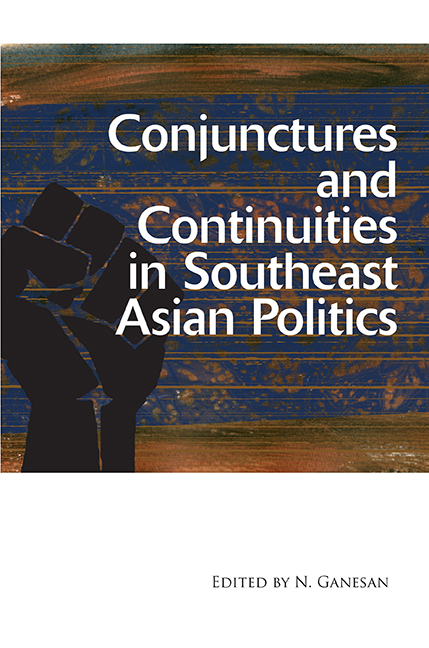Book contents
- Frontmatter
- Contents
- Acknowledgements
- List of Abbreviations
- Contributors
- 1 Conjunctures and Continuities in Southeast Asian Politics
- 2 (Re)Assessing the EDSA “People Power” (1986) as a Critical Conjuncture
- 3 The Road to Doi Moi in 1986: Domestic Dimensions
- 4 The 1988 Uprising in Myanmar: Historical Conjuncture or Praetorian Redux?
- 5 Cambodia's Historical Conjunctures and their Significance
- 6 Changing the Rules: Historical Conjuncture and Transition in Indonesia
- 7 The Resistible Rise of Thaksin Shinawatra: Crisis, Change and the Collapse of Thailand's Democracy
- 8 The March 2008 General Election in Malaysia as a Historical Conjuncture
- 9 Conclusion: Conjunctures and Continuities in Southeast Asia
- Index
3 - The Road to Doi Moi in 1986: Domestic Dimensions
Published online by Cambridge University Press: 21 October 2015
- Frontmatter
- Contents
- Acknowledgements
- List of Abbreviations
- Contributors
- 1 Conjunctures and Continuities in Southeast Asian Politics
- 2 (Re)Assessing the EDSA “People Power” (1986) as a Critical Conjuncture
- 3 The Road to Doi Moi in 1986: Domestic Dimensions
- 4 The 1988 Uprising in Myanmar: Historical Conjuncture or Praetorian Redux?
- 5 Cambodia's Historical Conjunctures and their Significance
- 6 Changing the Rules: Historical Conjuncture and Transition in Indonesia
- 7 The Resistible Rise of Thaksin Shinawatra: Crisis, Change and the Collapse of Thailand's Democracy
- 8 The March 2008 General Election in Malaysia as a Historical Conjuncture
- 9 Conclusion: Conjunctures and Continuities in Southeast Asia
- Index
Summary
In modern Vietnam one could argue that there were a number of turning points that made history. The proclamation of the independence of Vietnam in September 1945 and the subsequent birth of the Democratic Republic of Vietnam certainly constituted a milestone, which put an end to more than eighty years of French colonial rule. The French returned with an intention to re-capture power leading to the outbreak of the First Indochina War. The Paris Conference in 1954 following Vietnam's victory over the French in Dien Bien Phu marked the complete departure of the French from the North of Vietnam and the partition of the country at the 17th parallel. The United States replaced France to support the government of the Republic of South Vietnam and to scrap the Paris Accord on the holding of a general election to unify Vietnam in 1956. The Second Indochina War (better known as the Vietnam War) followed as a result and lasted for almost twenty years. The unification of Vietnam in 1975 led to American disengagement, ushering in a whole new period for a united Vietnam for the first time in more than one hundred years. However, these thirty years were the time when Vietnam had to fight for independence and national liberation, which was conducive to the shared common feature of constant war and armed struggle both in the North and in the South.
The reconstruction of a war-torn Vietnam only started after the political and institutional reunification of the country in 1976. Hanoi implemented a Soviet-type command economic policy with great hopes of success. Nevertheless, the expansion of the socialist economic sector had not brought about the expected outcomes. In the North of Vietnam, acceleration of implementing co-operatives and enlargement of their size were apparently successful. In substance, agricultural co-operatives had further deteriorated. The size of the co-operatives had gone well beyond the management capacity of the local management boards.
- Type
- Chapter
- Information
- Publisher: ISEAS–Yusof Ishak InstitutePrint publication year: 2013

